Unit 8 It must belong to Carla SectionB 2a--2e 课件(共31张PPT)
文档属性
| 名称 | Unit 8 It must belong to Carla SectionB 2a--2e 课件(共31张PPT) | 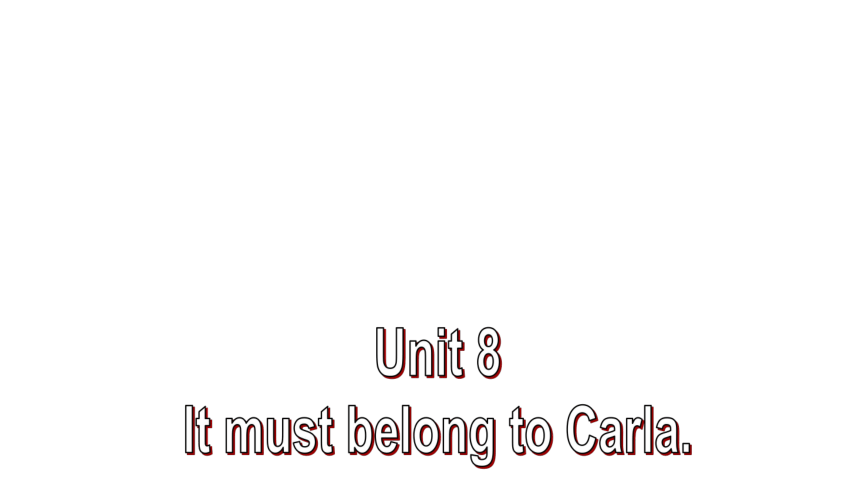 | |
| 格式 | pptx | ||
| 文件大小 | 14.6MB | ||
| 资源类型 | 教案 | ||
| 版本资源 | 人教新目标(Go for it)版 | ||
| 科目 | 英语 | ||
| 更新时间 | 2023-12-09 10:02:54 | ||
图片预览

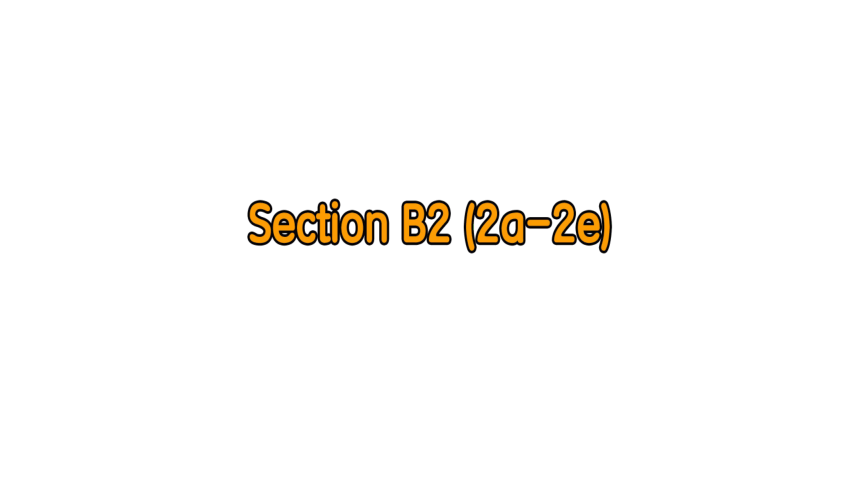
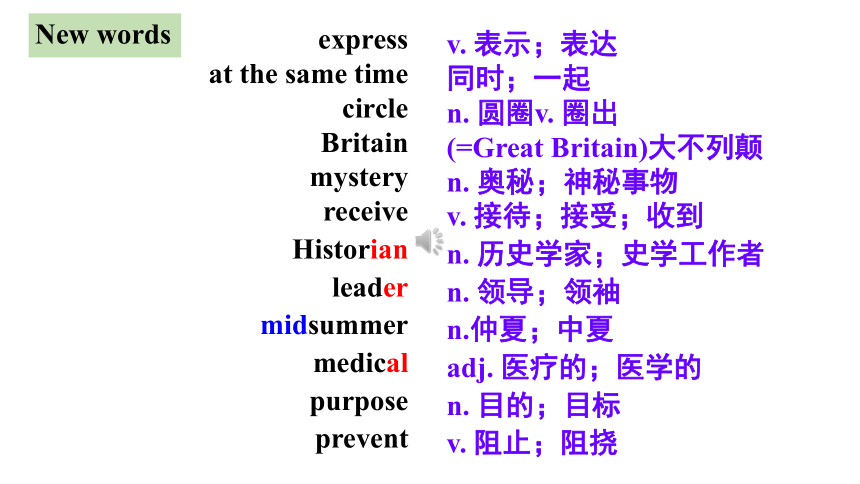
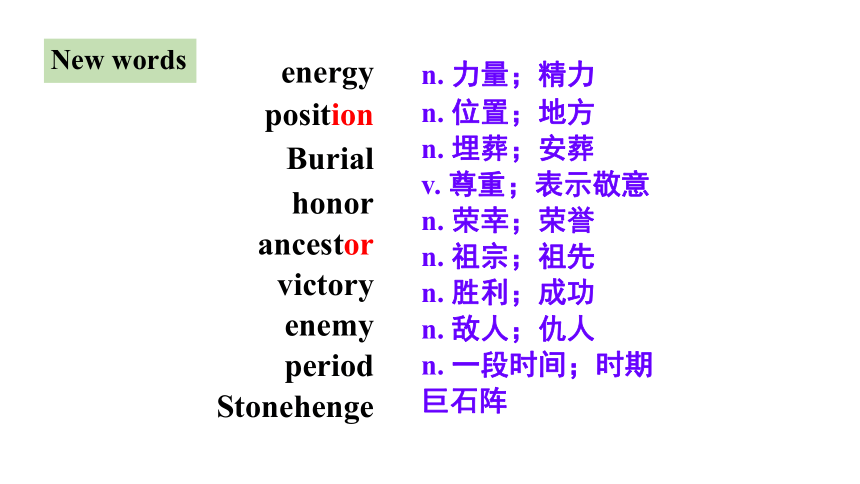
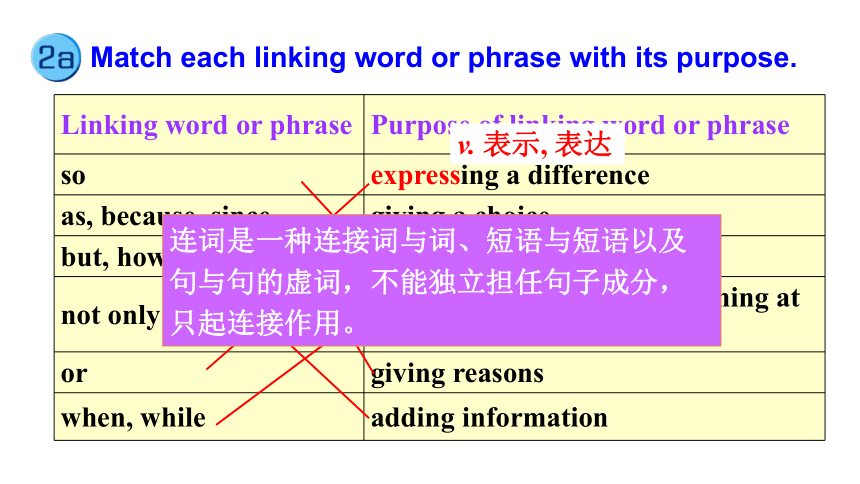
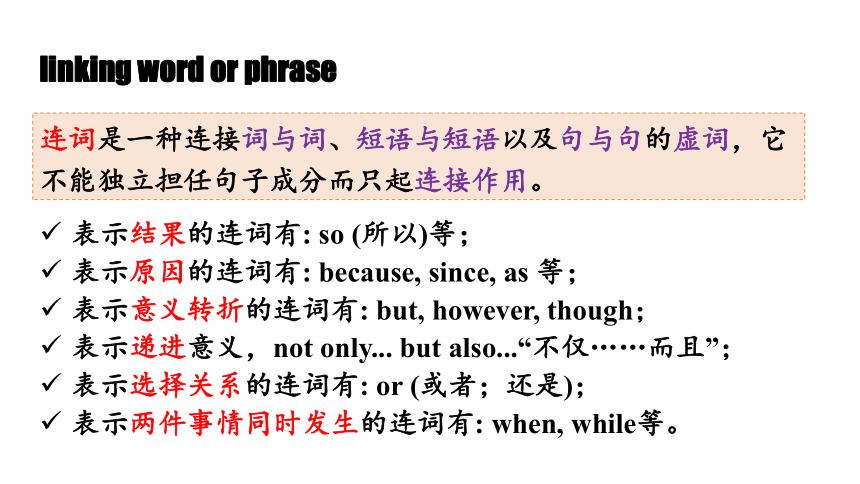
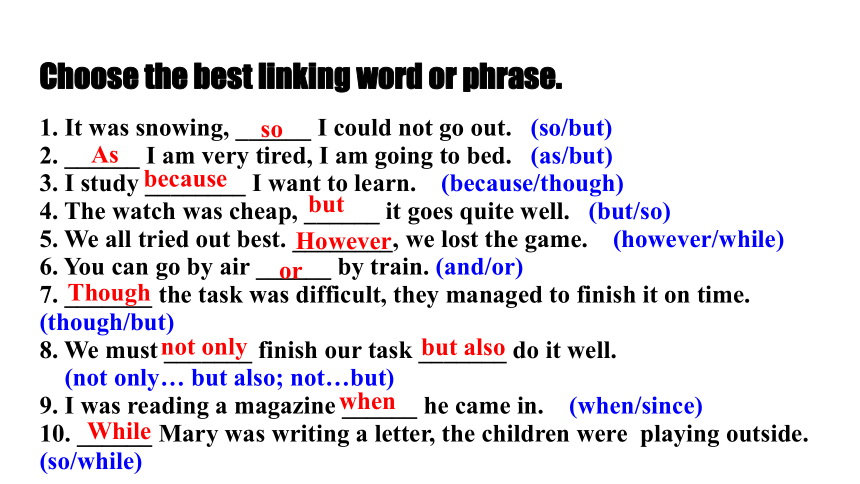
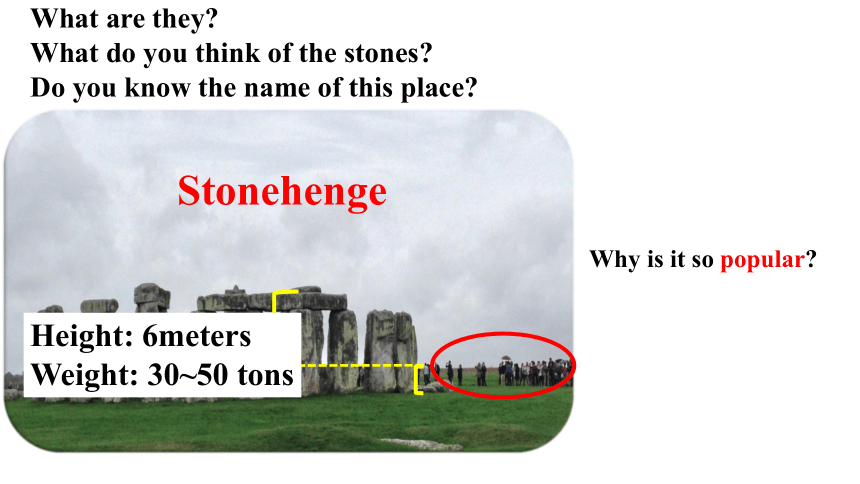
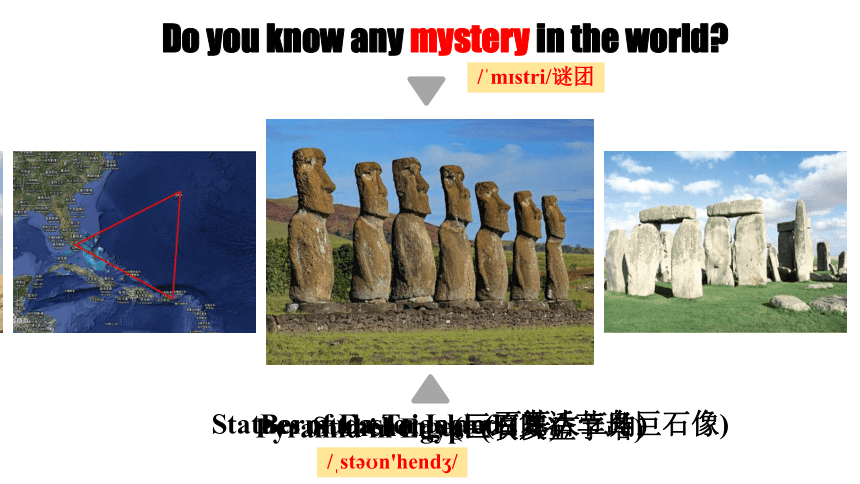
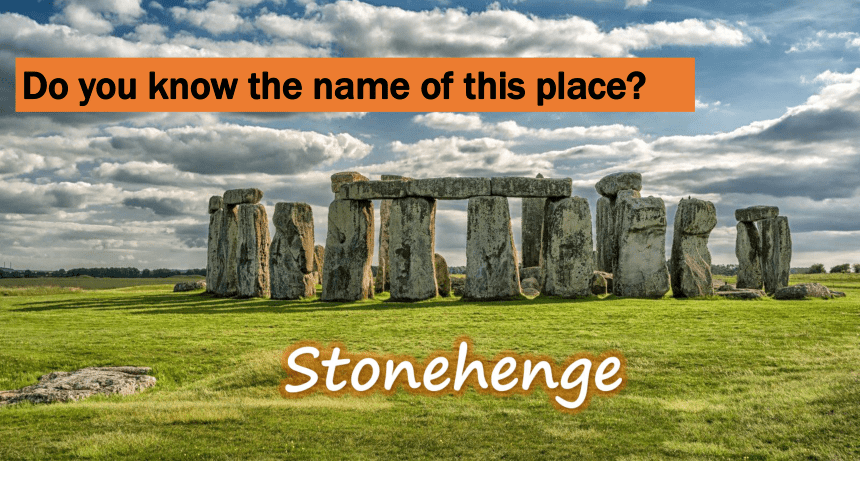
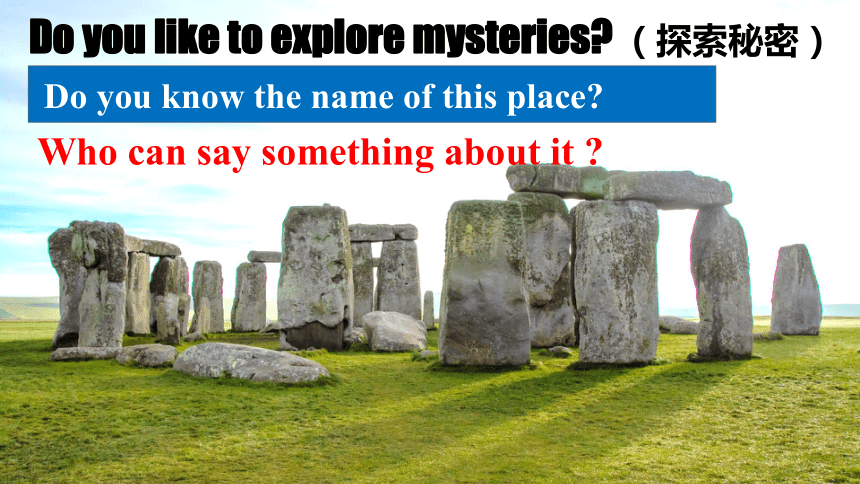
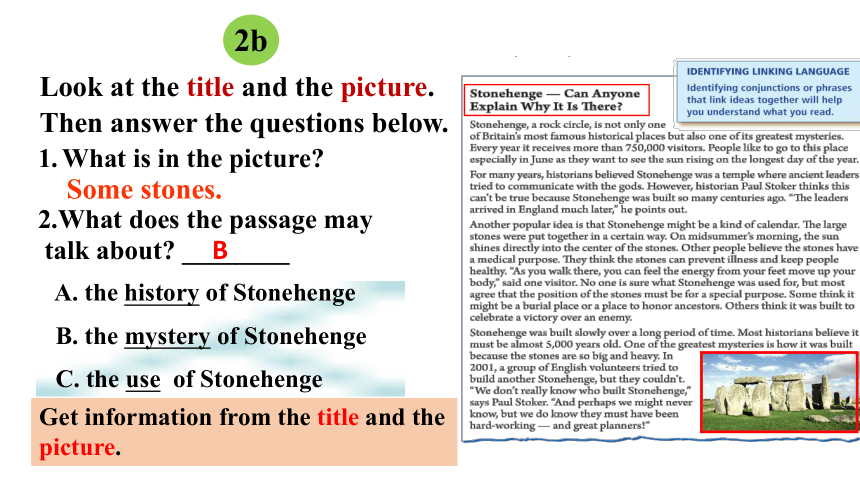
文档简介
(共31张PPT)
Unit 8
It must belong to Carla.
express
at the same time
circle
Britain
mystery
receive
Historian
leader
midsummer
medical
purpose
prevent
v. 表示;表达
同时;一起
n. 圆圈v. 圈出
(=Great Britain)大不列颠
n. 奥秘;神秘事物
v. 接待;接受;收到
n. 历史学家;史学工作者
n. 领导;领袖
n.仲夏;中夏
adj. 医疗的;医学的
n. 目的;目标
v. 阻止;阻挠
New words
energy
position
Burial
honor
ancestor
victory
enemy
period
Stonehenge
n. 力量;精力
n. 位置;地方
n. 埋葬;安葬
v. 尊重;表示敬意
n. 荣幸;荣誉
n. 祖宗;祖先
n. 胜利;成功
n. 敌人;仇人
n. 一段时间;时期
巨石阵
New words
Match each linking word or phrase with its purpose.
Linking word or phrase Purpose of linking word or phrase
so expressing a difference
as, because, since giving a choice
but, however, though expressing a result
not only ... but also expressing two things happening at the same time
or giving reasons
when, while adding information
v. 表示, 表达
连词是一种连接词与词、短语与短语以及句与句的虚词,不能独立担任句子成分,只起连接作用。
连词是一种连接词与词、短语与短语以及句与句的虚词,它不能独立担任句子成分而只起连接作用。
表示结果的连词有: so (所以)等;
表示原因的连词有: because, since, as 等;
表示意义转折的连词有: but, however, though;
表示递进意义,not only... but also...“不仅……而且”;
表示选择关系的连词有: or (或者;还是);
表示两件事情同时发生的连词有: when, while等。
linking word or phrase
Choose the best linking word or phrase.
1. It was snowing, ______ I could not go out. (so/but)
2. ______ I am very tired, I am going to bed. (as/but)
3. I study ________ I want to learn. (because/though)
4. The watch was cheap, ______ it goes quite well. (but/so)
5. We all tried out best. ________, we lost the game. (however/while)
6. You can go by air ______ by train. (and/or)
7. _______ the task was difficult, they managed to finish it on time.
(though/but)
8. We must _______ finish our task _______ do it well.
(not only… but also; not…but)
9. I was reading a magazine ______ he came in. (when/since)
10. ______ Mary was writing a letter, the children were playing outside. (so/while)
so
As
because
but
However
or
Though
not only
but also
when
While
What are they
What do you think of the stones
Do you know the name of this place
Why is it so popular
Stonehenge
Height: 6meters
Weight: 30~50 tons
Do you know any mystery in the world
Statues of Easter Island (复活节岛巨石像)
Bermuda Triangle(百慕大三角)
Pyramid in Egypt (埃及金字塔)
Stonehenge(巨石阵)
/ st n'hend /
/ m stri/谜团
Stonehenge
Do you know the name of this place
Do you like to explore mysteries (探索秘密)
Who can say something about it
Do you know the name of this place
Look at the title and the picture. Then answer the questions below.
What is in the picture
2.What does the passage may
talk about ________
Some stones.
A. the history of Stonehenge
B. the mystery of Stonehenge
C. the use of Stonehenge
B
Get information from the title and the picture.
2b
Presentation
Fast reading
While-reading
Read and answer.
1.How many paragraphs are there
2.Which paragraph gives a general introduction (总的介绍)
3. Can you find out the topic sentence of the article
Read the passage quickly and answer
the questions.
①
②
③
④
Four.
Para 1.
Stonehenge is not only one of Britain’s
most historical places but also one of its
greatest mysteries.
Tips: The theme(主题)of a passage often comes in the first paragraph, usually at the first or last sentence...
2b
Para.1 Different ideas about the purposes
of Stonehenge’s
Para.2&3 Mysteries about Stonehenge
Para.4 General introduction of Stonehenge
Read passage quickly and match.
n. 目标;目的
Name:___________
Place:____________
Materia and shape:________________
The number of visitors per year: _____________________
Best time to visit:__________
What people like to do: ____________________
Stonehenge
Rock circle
More than 750,000
In June
See the sun rising
Britain
General introduction
Read Para. 1 and fill in the table.
Stonehenge, a rock circle, is not only one of Britain’s most famous historical places but also one of its greatest mysteries. Every year it receives more than 750,000 visitors. People like to go to this place especially in June as they want to see the sun rising on the longest day of the year.
For many years, historians believed Stonehenge was a temple where ancient leaders tried to communicate with the gods. However, historian Paul Stoker thinks this can’t be true because Stonehenge was built so many centuries ago. “The leaders arrived in England much later,” he points out.
Read Para.2 and circle the linking words.
Careful reading
expressing a difference
giving reasons
Was Stonehenge a temple
Another popular idea is that Stonehenge might be a kind of calendar. The large stones were put together in a certain way. On midsummer’s morning, the sun shines directly into the center of the stones. Other people believe the stones have a medical purpose. They think the stones can prevent illness while keeping people healthy. “As you walk there, you can feel the energy from your feet climb up your body,” said one visitor. No one is sure what Stonehenge was used for, but most agree that the position of the stones must be for a special purpose. Some think it might be a burial place, or a place to honor ancestors. Others think it was built to celebrate a victory over an enemy.
Read Para.3 and circle the linking words.
Careful reading
expressing two thingshappening at the same time
expressing a difference
giving a choice
Careful reading
Who Ideas Supporting
_______________ temple Ancient leaders tried to _________________________ the gods.
Another ______________ On _____________________’s morning, the sun _________________ into the center of the stones
Other people ______________ can prevent____________ and
keep people_______________
Some It might be a________ place or a place to _______ ancestors
Others It was built to celebrate a __________ over an enemy.
Historians
communicate with
Complete the chart
according to Para.2 & 3.
Different ideas about
the purposes of Stonehenge
calendar
shines directly
midsummer
a medical
purpose
illness
healthy
burial
honor
victory
Read Para. 4 carefully and answer questions.
1. How old is Stonehenge believed to be
It must be 5,000 years old.
2. Was Stonehenge built overnight
No, it was built for a long period time.
3. What’s the biggest mystery of Stonehenge Why
One of the biggest mystery is how it was built. Because the stones are so big and high.
4. Was the volunteers successful in building another Stonehenge
No, they failed to build another Stonehenge.
5. What are we sure of the builder of Stonehenge
They must have been hard-working and great planners.
2c
Mysteries about Stonehenge What Stonehenge might have been used for…
Who built it What was it used for
How was it built
Read the article again and complete the chart.
1.as a temple where ancient
leaders tried to
communicate with the gods
2.a kind of calendar
3.have a medical purpose
4.might be a burial place, or
a place to honor ancestors
5. celebrate a victory over
an enemy
Complete the sentences with the correct linking words.
2d
Let’s do
Midsummer day is in June __________ a lot of people go to Stonehenge during this month.
The sun shines straight into the Stonehenge _______ the stones were put in a special position.
3. Some people think the rocks can ____________ stop people from becoming ill _________ keep them healthy.
4. We don’t know who built Stonehenge _________ how it was built.
5. Historians think Stonehenge was built about 5,000 years ago; _________, they are not sure.
and
as
not only
but also
or
however
一种特别的位置
阻止某人做某事
2e
(1) What do you know about these mysteries
(2) What is mysterious about them
[ p r m d]
Statues of Easter Island
(复活节岛巨石像)
Can you think of any other mysteries, either in China or another part of the world, that are similar to Stonehenge
Language points
1. expressing a difference
express v. 表达,表示 expression n. 表达, 表示, 表情
我发觉难以表达我的意思。
我送给他们鲜花以表示感谢。
I find it difficult to express my meaning.
I sent them flowers as an expression of thanks.
面部表情
facial expression
2.Every year it receives more than 750, 000 visitors.
这里每年都能迎来75万多名游客。
receive “接待,收到”,强调客观上收到这一事实,不表明是否愿意接受此物
accept “接受”,主动地或自愿地接受,带有满意、同意、答应、认可等意味,其反义词为 refuse
receive
accept
I received his invitation to the party yesterday, but I refused to accept it.
昨天我收到了他的聚会请柬,但我拒绝接受。
2.用receive或accept的适当形式填空。
1) Laura __________ some flowers yesterday, but she didn’t know if she should ________ them.
2) Dick __________ lots of support from his parents.
3) Every year the hotel ________ guests from all over the world.
receives
received
received
accept
receive & accept
receive accept 例句
含义 只表示“收到”这一客观事实 主观上“接受” Yesterday I received his gift, but I didn’t accept it and returned it to him.
搭配 表接受教育;受到(某种待遇);得到支持等,常用receive accept无此用法 All the children at this age should receive education.
1) I will be happy if Sandy __________(接受) my offer.
2) Julia __________(receive / accept) presents from her son on Mother’s Day every year.
3) I went to the door to __________(receive / accept) those visitors.
4) Li Hua __________(receive / accept) a warm welcome when she was in England.
【语境应用】完成句子。
accepts
receives
receive
received
3. For many years, historians believed Stonehenge was a temple where ancient leaders tried to communicate with the gods.
关系副词where引导的定语从句
本句中,where在定语从句中作地点状语,修饰名词temple。本句可译为:多年以来,历史学家们认为巨石阵是古代首领试图与神灵交流的庙宇。
3. Other people believe the stones have a medical purpose.
medical adj. 医疗的;医学的 medicine uc.药 take medicine
我的姐姐在医学院上学。
My sister studies at a medical college.
purpose n. 目的;目标 the purpose of... “......的目的”
on purpose“有意地;故意”(反义短语为by accident)
他故意把我的自行车弄坏了。
He broke my bike on purpose.
4. They think the stones can prevent illness and keep people healthy.
prevent sb. (from) doing sth.
=stop sb. (from) doing sth.
=keep sb. (from) doing sth. “阻止某人做某事”
我们能做什么来防止这种疾病传播呢?
我们必须采取有效措施遏制交通事故的增长。
What can we do to prevent the disease (from) spreading
We must take effective measures to prevent traffic accidents from increasing.
1.不仅,而且
2. 历史古迹
3. 古代首领
4. 与神灵沟通
5. 多个世纪以前
6. 指出
7.一种日历
8. 以一种特定的方式
9. 在仲夏的早晨
10.直射在..
11.有医疗用途
12.庆祝战胜敌人
13. 经历很长一段时间
1.not only...but also
2. historical places
3. ancient leaders
4. communicate with the gods
5. centuries ago
6. point out
7. a kind of calendar
8. in a certain way
9. on midsummer's morning
10. shine directly
11. have a medical purpose
12. celebrate a victory over an enemy.
13. over a long period of time.
Phrases
Homework
1. Finish the exercises in the workbook.
2. Retell the passage
3. Write a passage about the mysteries.
4. Preview the new words and expressions.
Unit 8
It must belong to Carla.
express
at the same time
circle
Britain
mystery
receive
Historian
leader
midsummer
medical
purpose
prevent
v. 表示;表达
同时;一起
n. 圆圈v. 圈出
(=Great Britain)大不列颠
n. 奥秘;神秘事物
v. 接待;接受;收到
n. 历史学家;史学工作者
n. 领导;领袖
n.仲夏;中夏
adj. 医疗的;医学的
n. 目的;目标
v. 阻止;阻挠
New words
energy
position
Burial
honor
ancestor
victory
enemy
period
Stonehenge
n. 力量;精力
n. 位置;地方
n. 埋葬;安葬
v. 尊重;表示敬意
n. 荣幸;荣誉
n. 祖宗;祖先
n. 胜利;成功
n. 敌人;仇人
n. 一段时间;时期
巨石阵
New words
Match each linking word or phrase with its purpose.
Linking word or phrase Purpose of linking word or phrase
so expressing a difference
as, because, since giving a choice
but, however, though expressing a result
not only ... but also expressing two things happening at the same time
or giving reasons
when, while adding information
v. 表示, 表达
连词是一种连接词与词、短语与短语以及句与句的虚词,不能独立担任句子成分,只起连接作用。
连词是一种连接词与词、短语与短语以及句与句的虚词,它不能独立担任句子成分而只起连接作用。
表示结果的连词有: so (所以)等;
表示原因的连词有: because, since, as 等;
表示意义转折的连词有: but, however, though;
表示递进意义,not only... but also...“不仅……而且”;
表示选择关系的连词有: or (或者;还是);
表示两件事情同时发生的连词有: when, while等。
linking word or phrase
Choose the best linking word or phrase.
1. It was snowing, ______ I could not go out. (so/but)
2. ______ I am very tired, I am going to bed. (as/but)
3. I study ________ I want to learn. (because/though)
4. The watch was cheap, ______ it goes quite well. (but/so)
5. We all tried out best. ________, we lost the game. (however/while)
6. You can go by air ______ by train. (and/or)
7. _______ the task was difficult, they managed to finish it on time.
(though/but)
8. We must _______ finish our task _______ do it well.
(not only… but also; not…but)
9. I was reading a magazine ______ he came in. (when/since)
10. ______ Mary was writing a letter, the children were playing outside. (so/while)
so
As
because
but
However
or
Though
not only
but also
when
While
What are they
What do you think of the stones
Do you know the name of this place
Why is it so popular
Stonehenge
Height: 6meters
Weight: 30~50 tons
Do you know any mystery in the world
Statues of Easter Island (复活节岛巨石像)
Bermuda Triangle(百慕大三角)
Pyramid in Egypt (埃及金字塔)
Stonehenge(巨石阵)
/ st n'hend /
/ m stri/谜团
Stonehenge
Do you know the name of this place
Do you like to explore mysteries (探索秘密)
Who can say something about it
Do you know the name of this place
Look at the title and the picture. Then answer the questions below.
What is in the picture
2.What does the passage may
talk about ________
Some stones.
A. the history of Stonehenge
B. the mystery of Stonehenge
C. the use of Stonehenge
B
Get information from the title and the picture.
2b
Presentation
Fast reading
While-reading
Read and answer.
1.How many paragraphs are there
2.Which paragraph gives a general introduction (总的介绍)
3. Can you find out the topic sentence of the article
Read the passage quickly and answer
the questions.
①
②
③
④
Four.
Para 1.
Stonehenge is not only one of Britain’s
most historical places but also one of its
greatest mysteries.
Tips: The theme(主题)of a passage often comes in the first paragraph, usually at the first or last sentence...
2b
Para.1 Different ideas about the purposes
of Stonehenge’s
Para.2&3 Mysteries about Stonehenge
Para.4 General introduction of Stonehenge
Read passage quickly and match.
n. 目标;目的
Name:___________
Place:____________
Materia and shape:________________
The number of visitors per year: _____________________
Best time to visit:__________
What people like to do: ____________________
Stonehenge
Rock circle
More than 750,000
In June
See the sun rising
Britain
General introduction
Read Para. 1 and fill in the table.
Stonehenge, a rock circle, is not only one of Britain’s most famous historical places but also one of its greatest mysteries. Every year it receives more than 750,000 visitors. People like to go to this place especially in June as they want to see the sun rising on the longest day of the year.
For many years, historians believed Stonehenge was a temple where ancient leaders tried to communicate with the gods. However, historian Paul Stoker thinks this can’t be true because Stonehenge was built so many centuries ago. “The leaders arrived in England much later,” he points out.
Read Para.2 and circle the linking words.
Careful reading
expressing a difference
giving reasons
Was Stonehenge a temple
Another popular idea is that Stonehenge might be a kind of calendar. The large stones were put together in a certain way. On midsummer’s morning, the sun shines directly into the center of the stones. Other people believe the stones have a medical purpose. They think the stones can prevent illness while keeping people healthy. “As you walk there, you can feel the energy from your feet climb up your body,” said one visitor. No one is sure what Stonehenge was used for, but most agree that the position of the stones must be for a special purpose. Some think it might be a burial place, or a place to honor ancestors. Others think it was built to celebrate a victory over an enemy.
Read Para.3 and circle the linking words.
Careful reading
expressing two thingshappening at the same time
expressing a difference
giving a choice
Careful reading
Who Ideas Supporting
_______________ temple Ancient leaders tried to _________________________ the gods.
Another ______________ On _____________________’s morning, the sun _________________ into the center of the stones
Other people ______________ can prevent____________ and
keep people_______________
Some It might be a________ place or a place to _______ ancestors
Others It was built to celebrate a __________ over an enemy.
Historians
communicate with
Complete the chart
according to Para.2 & 3.
Different ideas about
the purposes of Stonehenge
calendar
shines directly
midsummer
a medical
purpose
illness
healthy
burial
honor
victory
Read Para. 4 carefully and answer questions.
1. How old is Stonehenge believed to be
It must be 5,000 years old.
2. Was Stonehenge built overnight
No, it was built for a long period time.
3. What’s the biggest mystery of Stonehenge Why
One of the biggest mystery is how it was built. Because the stones are so big and high.
4. Was the volunteers successful in building another Stonehenge
No, they failed to build another Stonehenge.
5. What are we sure of the builder of Stonehenge
They must have been hard-working and great planners.
2c
Mysteries about Stonehenge What Stonehenge might have been used for…
Who built it What was it used for
How was it built
Read the article again and complete the chart.
1.as a temple where ancient
leaders tried to
communicate with the gods
2.a kind of calendar
3.have a medical purpose
4.might be a burial place, or
a place to honor ancestors
5. celebrate a victory over
an enemy
Complete the sentences with the correct linking words.
2d
Let’s do
Midsummer day is in June __________ a lot of people go to Stonehenge during this month.
The sun shines straight into the Stonehenge _______ the stones were put in a special position.
3. Some people think the rocks can ____________ stop people from becoming ill _________ keep them healthy.
4. We don’t know who built Stonehenge _________ how it was built.
5. Historians think Stonehenge was built about 5,000 years ago; _________, they are not sure.
and
as
not only
but also
or
however
一种特别的位置
阻止某人做某事
2e
(1) What do you know about these mysteries
(2) What is mysterious about them
[ p r m d]
Statues of Easter Island
(复活节岛巨石像)
Can you think of any other mysteries, either in China or another part of the world, that are similar to Stonehenge
Language points
1. expressing a difference
express v. 表达,表示 expression n. 表达, 表示, 表情
我发觉难以表达我的意思。
我送给他们鲜花以表示感谢。
I find it difficult to express my meaning.
I sent them flowers as an expression of thanks.
面部表情
facial expression
2.Every year it receives more than 750, 000 visitors.
这里每年都能迎来75万多名游客。
receive “接待,收到”,强调客观上收到这一事实,不表明是否愿意接受此物
accept “接受”,主动地或自愿地接受,带有满意、同意、答应、认可等意味,其反义词为 refuse
receive
accept
I received his invitation to the party yesterday, but I refused to accept it.
昨天我收到了他的聚会请柬,但我拒绝接受。
2.用receive或accept的适当形式填空。
1) Laura __________ some flowers yesterday, but she didn’t know if she should ________ them.
2) Dick __________ lots of support from his parents.
3) Every year the hotel ________ guests from all over the world.
receives
received
received
accept
receive & accept
receive accept 例句
含义 只表示“收到”这一客观事实 主观上“接受” Yesterday I received his gift, but I didn’t accept it and returned it to him.
搭配 表接受教育;受到(某种待遇);得到支持等,常用receive accept无此用法 All the children at this age should receive education.
1) I will be happy if Sandy __________(接受) my offer.
2) Julia __________(receive / accept) presents from her son on Mother’s Day every year.
3) I went to the door to __________(receive / accept) those visitors.
4) Li Hua __________(receive / accept) a warm welcome when she was in England.
【语境应用】完成句子。
accepts
receives
receive
received
3. For many years, historians believed Stonehenge was a temple where ancient leaders tried to communicate with the gods.
关系副词where引导的定语从句
本句中,where在定语从句中作地点状语,修饰名词temple。本句可译为:多年以来,历史学家们认为巨石阵是古代首领试图与神灵交流的庙宇。
3. Other people believe the stones have a medical purpose.
medical adj. 医疗的;医学的 medicine uc.药 take medicine
我的姐姐在医学院上学。
My sister studies at a medical college.
purpose n. 目的;目标 the purpose of... “......的目的”
on purpose“有意地;故意”(反义短语为by accident)
他故意把我的自行车弄坏了。
He broke my bike on purpose.
4. They think the stones can prevent illness and keep people healthy.
prevent sb. (from) doing sth.
=stop sb. (from) doing sth.
=keep sb. (from) doing sth. “阻止某人做某事”
我们能做什么来防止这种疾病传播呢?
我们必须采取有效措施遏制交通事故的增长。
What can we do to prevent the disease (from) spreading
We must take effective measures to prevent traffic accidents from increasing.
1.不仅,而且
2. 历史古迹
3. 古代首领
4. 与神灵沟通
5. 多个世纪以前
6. 指出
7.一种日历
8. 以一种特定的方式
9. 在仲夏的早晨
10.直射在..
11.有医疗用途
12.庆祝战胜敌人
13. 经历很长一段时间
1.not only...but also
2. historical places
3. ancient leaders
4. communicate with the gods
5. centuries ago
6. point out
7. a kind of calendar
8. in a certain way
9. on midsummer's morning
10. shine directly
11. have a medical purpose
12. celebrate a victory over an enemy.
13. over a long period of time.
Phrases
Homework
1. Finish the exercises in the workbook.
2. Retell the passage
3. Write a passage about the mysteries.
4. Preview the new words and expressions.
同课章节目录
- Unit 1 How can we become good learners.
- Section A
- Section B
- Unit 2 I think that mooncakes are delicious!
- Section A
- Section B
- Unit 3 Could you please tell me where the restroom
- Section A
- Section B
- Unit 4 I used to be afraid of the dark.
- Section A
- Section B
- Unit 5 What are the shirts made of?
- Section A
- Section B
- Review of Units 1-5
- Unit 6 When was it invented?
- Section A
- Section B
- Unit 7 Teenagers should be allowed to choose their
- Section A
- Section B
- Unit 8 It must belong to Carla.
- Section A
- Section B
- Unit 9 I like music that I can dance to.
- Section A
- Section B
- Unit 10 You're supposed to shake hands.
- Section A
- Section B
- Review of Units 6-10
- Unit 11 Sad movies make me cry.
- Section A
- Section B
- Unit 12 Life is full of the unexpected
- Section A
- Section B
- Unit 13 We're trying to save the earth!
- Section A
- Section B
- Unit 14 I remember meeting all of you in Grade 7.
- Section A
- Section B
- Review of Units 11-14
